engine overheat CADILLAC DEVILLE 1998 7.G Owners Manual
[x] Cancel search | Manufacturer: CADILLAC, Model Year: 1998, Model line: DEVILLE, Model: CADILLAC DEVILLE 1998 7.GPages: 386, PDF Size: 22.36 MB
Page 2 of 386
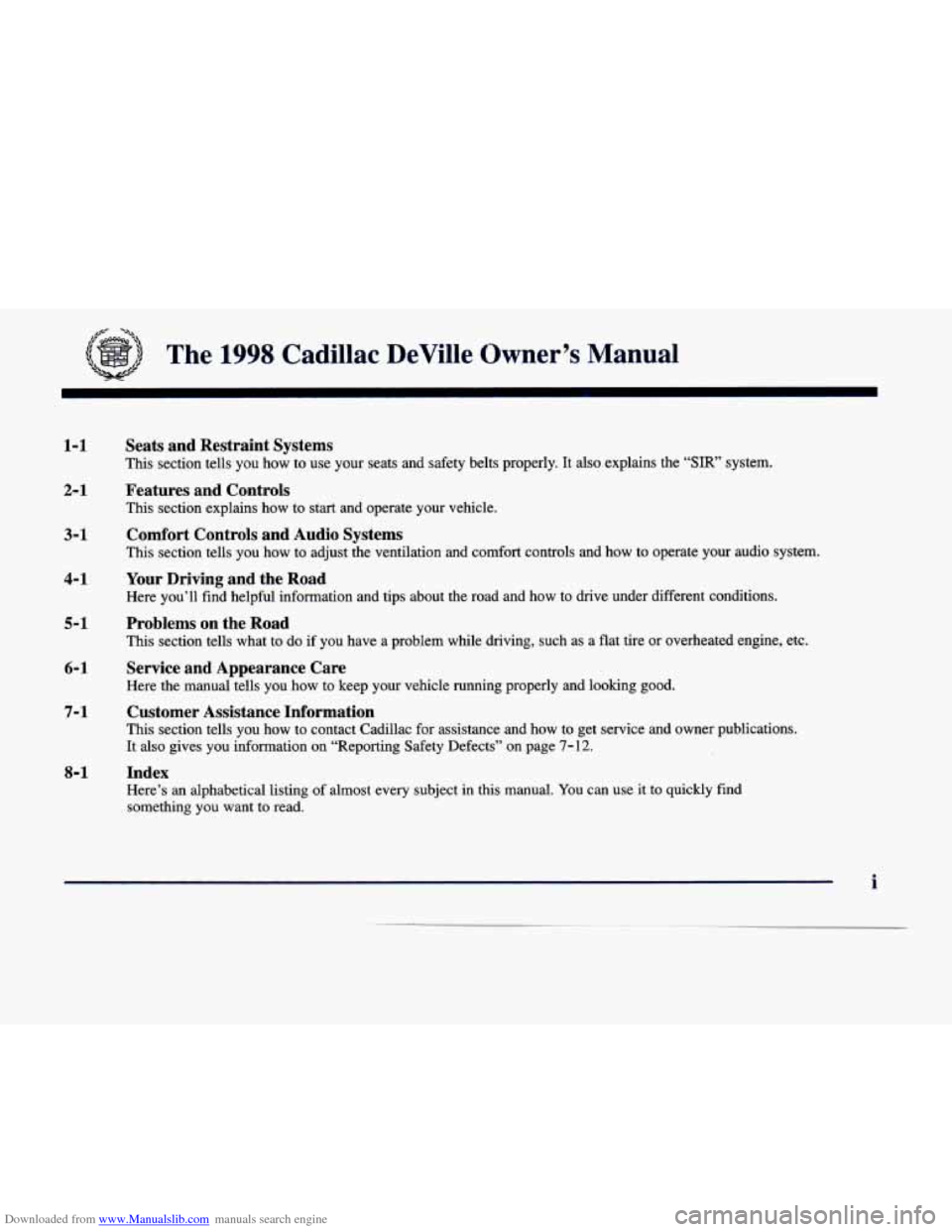
Downloaded from www.Manualslib.com manuals search engine tfi- ==
The 1998 Cadillac DeVille Owner’s Manual
1-1
2-1
3- 1
Seats and Restraint Systems
This section tells you how to use your seats and safety belts prop\
erly. It also explains the “SIR” system.
Features and Controls
This section explains how to start and operate your vehicle.
Comfort Controls and Audio Systems
This section tells you how to adjust the ventilation and comfort co\
ntrols and how to operate your audio system.
4- 1 Your Driving and the Road
Here you’ll find helpful information and tips about the road\
and how to drive under different conditions.
5- 1
6- 1
7-1
8-1
Problems on the Road
This section tells what to do if you have a problem while driving, such as a flat tire or overheated en\
gine, etc.
Service and Appearance Care
Here the manual tells you how to keep your vehicle running pr\
operly and looking good.
Customer Assistance Information
This section tells you how to contact Cadillac for assistance and how to get service and owner publications.
It also gives you information on “Reporting Safety Defects” o\
n page 7-12.
Index
Here’s an alphabetical listing of almost every subject in this manual. You can use it to quickly find
something you want to read.
i
Page 93 of 386
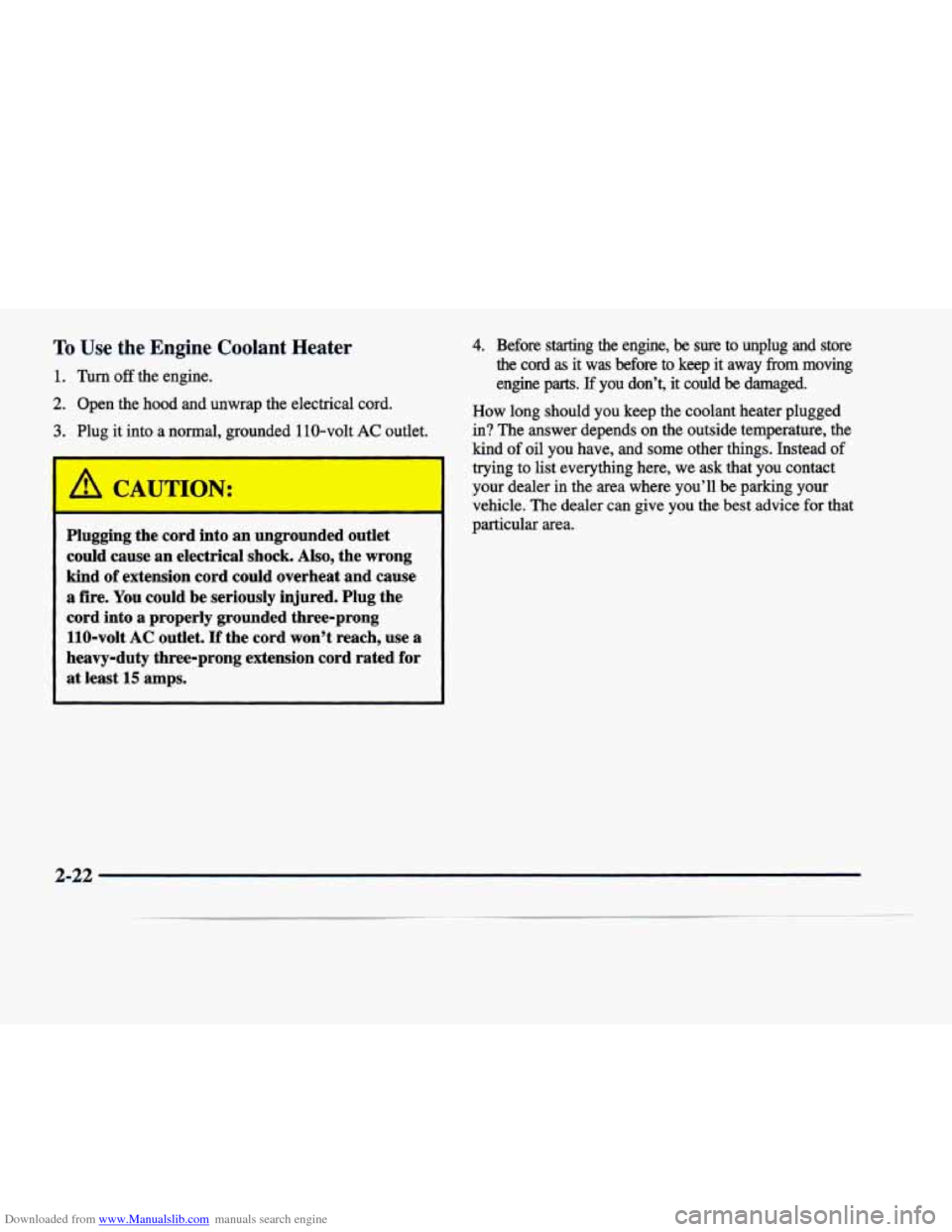
Downloaded from www.Manualslib.com manuals search engine To Use the Engine Coolant Heater
1. Turn off the engine.
2. Open the hood and unwrap the electrical cord.
3. Plug it into a normal, grounded 110-volt AC outlet.
-
Plugging the cord into an ungrounded outlet
could cause an electrical shock. Also, the wrong
kind
of extension cord could overheat and cause
a fire. You could be seriously injured. Plug the
cord into
a properly grounded three-prong
110-volt
AC outlet. If the cord won’t reach, use a
heavy-duty three-prong extension cord rated for
at least 15 amps.
4. Before starting the engine, be sure to unplug and store
the cord as it was before to keep it away from moving
engine parts.
If you don’t, it could be damaged.
How long should you keep the coolant heater plugged
in? The answer depends on the outside temperature, the
kind of oil you have,
and some other things. Instead of
trying to list everything here, we ask that you contact
your dealer in the area where you’ll be parking
your
vehicle. The dealer can give you the best advice for that
particular area.
2-22
Page 97 of 386
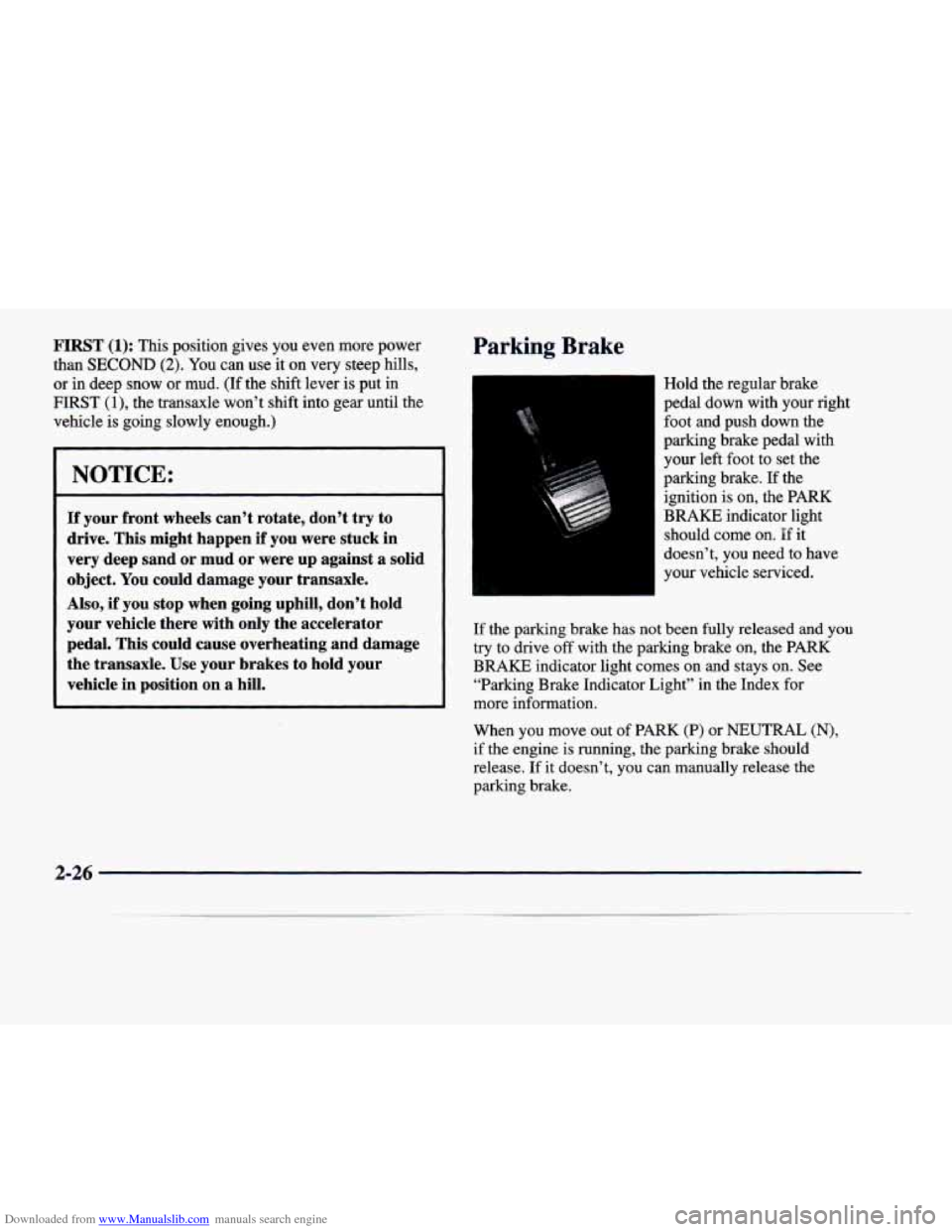
Downloaded from www.Manualslib.com manuals search engine FIRST (1): This position gives you even more power
than
SECOND (2). You can use it on very steep hills,
or
in deep snow or mud. (If the shft lever is put in
FIRST (l), the transaxle won’t shift into gear until the
vehicle is going slowly enough.)
I NOTICE:
- ~~
If your front wheels can’t rotate, don’t try to
drive. This might happen if you were stuck in
very deep sand
or mud or were up against a solid
object.
You could damage your transaxle.
Also, if you stop when going uphill, don’t hold
your vehicle there with only the accelerator
pedal. This could cause overheating and damage
the transaxle.
Use your brakes to hold your
vehicle in position on a hill.
Parking Brake
Hold the regular brake
pedal down with your right
foot and push down the
parking brake pedal with
your left foot to set the
parking brake. If the
ignition is on, the PARK
BRAKE indicator light
should come on.
If it
doesn’t, you need to have
your vehicle serviced.
If the parking brake has not been fully released and you
try to drive off with the parking brake on, the PARK
BRAKE indicator light comes on and stays on. See “Parking Brake Indicator Light” in the Index for
more information.
When you move out of PARK
(P) or NEUTRAL (N),
if the engine is running, the parking brake should
release. If it doesn’t, you can manually release the
parking brake.
2-26
Page 98 of 386
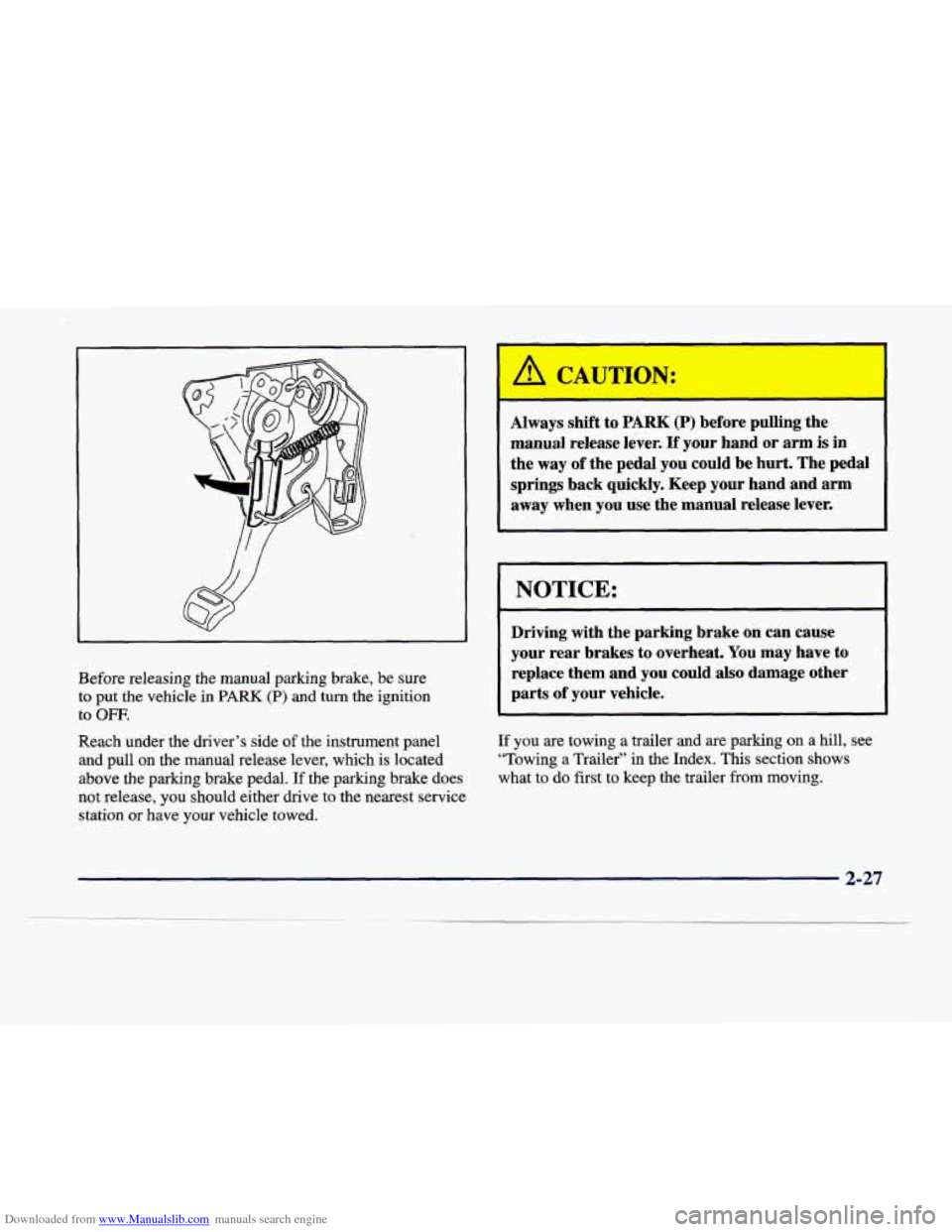
Downloaded from www.Manualslib.com manuals search engine Before releasing the manual parking brake, be sure
to put the vehicle
in PARK (P) and turn the ignition
to
OFF.
Reach under the driver’s side of the instrument panel
and pull on the manual release lever, which is located above the parking brake pedal.
If the parking brake does
not release,
you should either drive to the nearest service
station or have
your vehicle towed.
Always shift to PARK (P) before pulling the
manual release lever.
If your hand or arm is in
the way
of the pedal you could be hurt. The pedal
springs back quickly. Keep your hand and arm
away when you use the manual release lever.
NOTICE:
Driving with the parking brake on can cause
your rear brakes to overheat. You may have to
replace them and you could also damage other
parts
of your vehicle.
If you are towing a trailer and are parking on a hill, see
“Towing a Trailer” in the Index. This section shows
what
to do first to keep the trailer from moving.
---e 2-27
Page 101 of 386
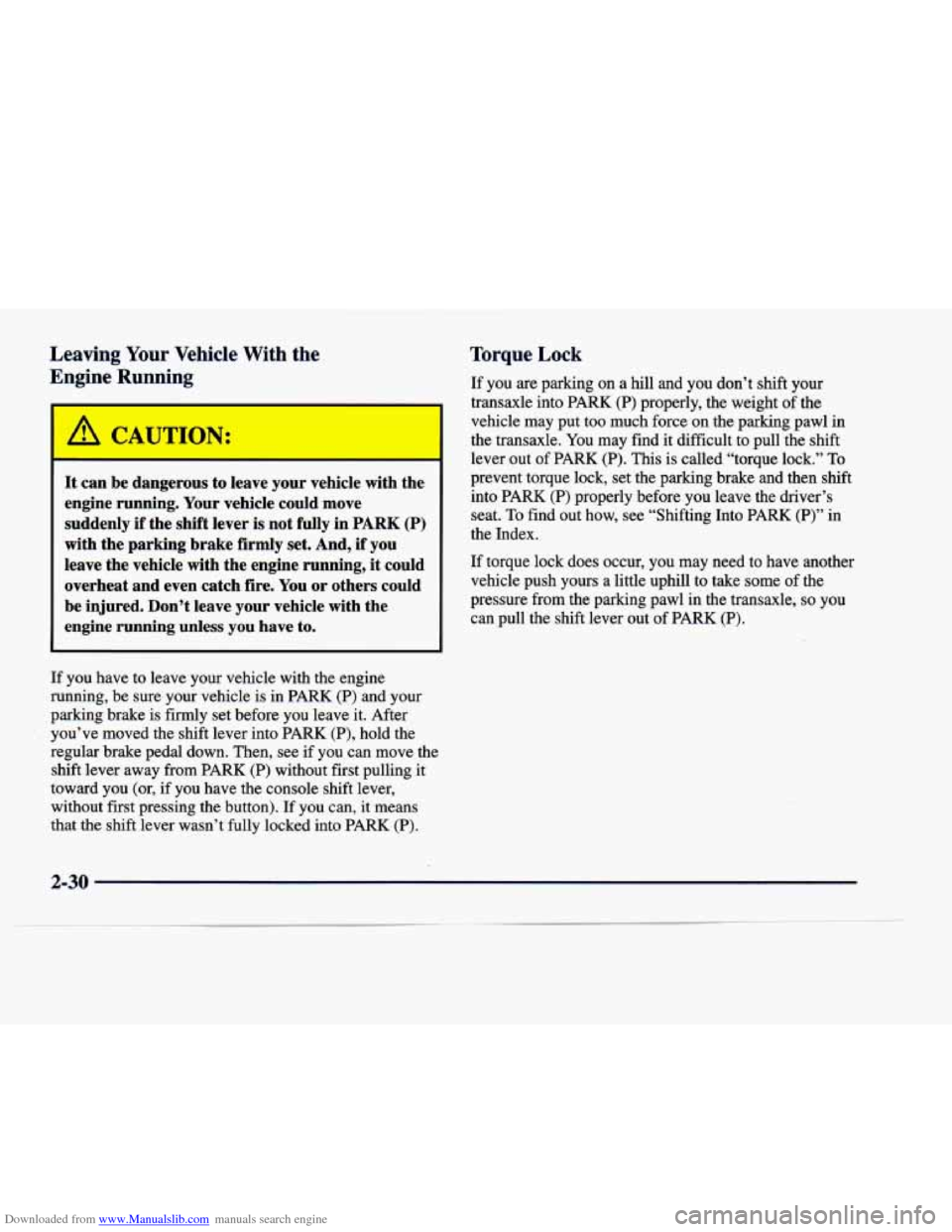
Downloaded from www.Manualslib.com manuals search engine Leaving Your Vehicle With the
Engine Running
It can be dangerous to leave your vehicle with the
engine running. Your vehicle could move
suddenly if the shift lever
is not fully in PARK (P)
with the parking brake firmly set. And, if you
leave the vehicle with the engine running, it could overheat and even catch fire. You or others could
be injured. Don’t leave your vehicle with the
engine running unless you have
to.
If you have to leave your vehicle with the engine
running, be sure your vehicle is in PARK
(P) and your
parking brake is
firmly set before you leave it. After
you’ve moved the shift lever into
PARK (P), hold the
regular brake pedal down. Then, see if you can move the
shift lever away from
PARK (P) without first pulling it
toward you (or, if you have the console shift lever,
without first pressing the button).
If you can, it means
that the shift lever wasn’t fully locked into
PARK (P).
Torque Lock
If you are parking on a hill and you don’t shift your
transaxle into PARK (P) properly,
the weight of the
vehicle may put too much force on the parking pawl in
the transaxle. You may find it difficult to pull the shift
lever out of PARK (P). This is called “torque lock.”
To
prevent torque lock, set the parking brake and then shift
into PARK
(P) properly before you leave the driver’s
seat. To find out how, see “Shifting Into PARK (P)” in
the Index.
If torque
lock does occur, you may need to have another
vehicle push yours a little uphill to take some of the
pressure from the parking pawl in the transaxle,
so you
can pull the shift lever out of PARK (P).
2-30
Page 127 of 386
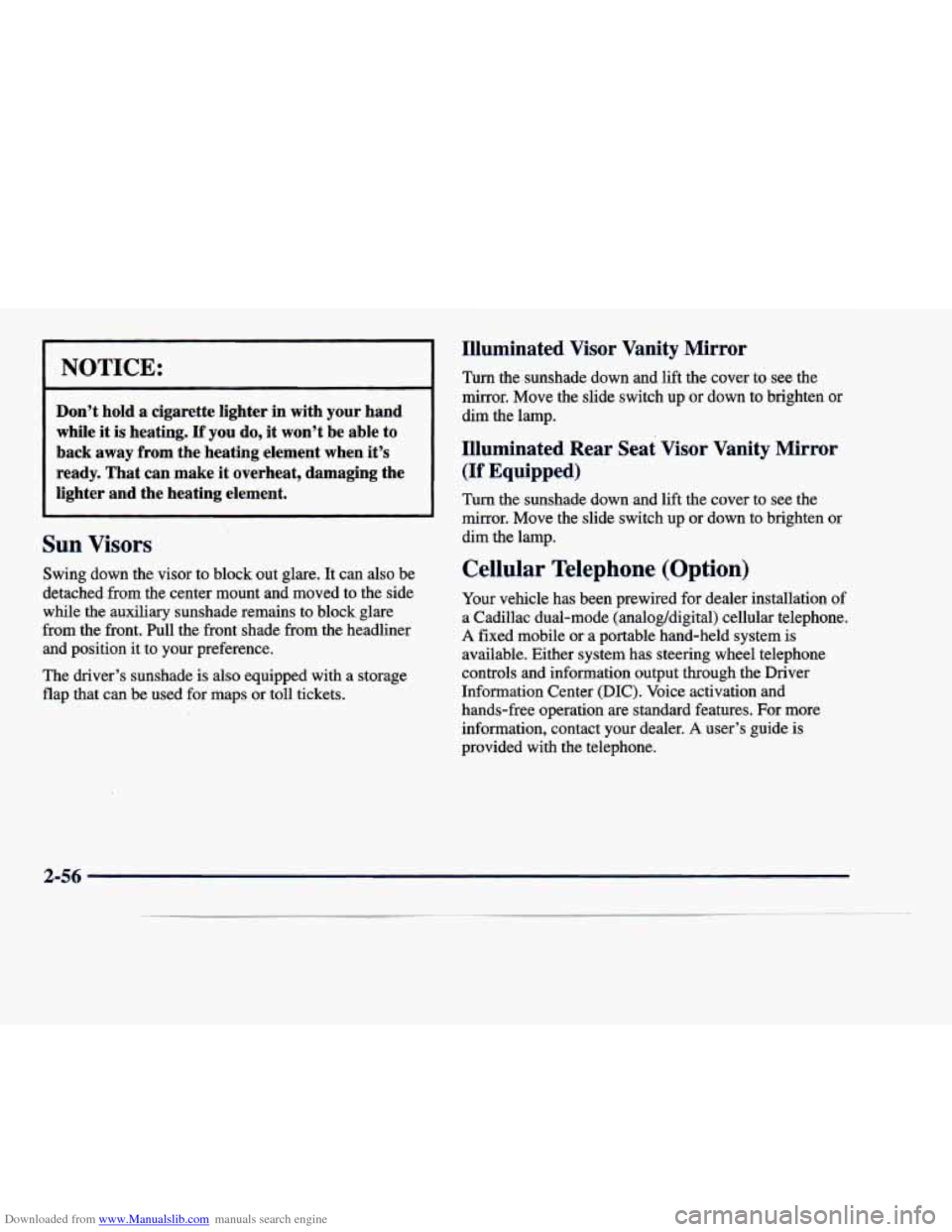
Downloaded from www.Manualslib.com manuals search engine NOTICE:
Illuminated Visor Vanity Mirror
Turn the sunshade down and lift the cover to see the
mirror. Move the slide switch
up or down to brighten or
Don’t hold a cigarette lighter in with your hand
while it is heating.
If you do, it won’t be able to
dim the lamp.
lighter and the heating element. Turn the sunshade down and lift the cover to see the
(If Equipped) ready. That can make it overheat, damaging the
Illuminated Rear Seat Visor Vanity Mirror back away from the heating element when it’s
mirror. Move the slide switch up or down to brighten or
dim the lamp.
ur 7isors
awing down the visor to block out glare. It can also be Cellular Telephone (Option)
detached from the center mount and moved to the side
Your vehicle has been prewired for dealer installation of
while the auxiliary sunshade remains to block glare a Cadillac dual-mode (analog/digital) cellular telephone.
from the front.
hll the front shade from the headliner A fixed mobile or a portable hand-heid system is
and position it to your preference.
available. Either system has steering wheel telephone
The driver’s sunshade is
also equipped with a storage controls and information output through the Driver
flap that can be used for maps or toll tickets. Information Center (DIC). Voice activation and
hands-free operation are standard features. For more
information, contact your dealer.
A user’s guide is
provided with the telephone.
2-56
Page 143 of 386
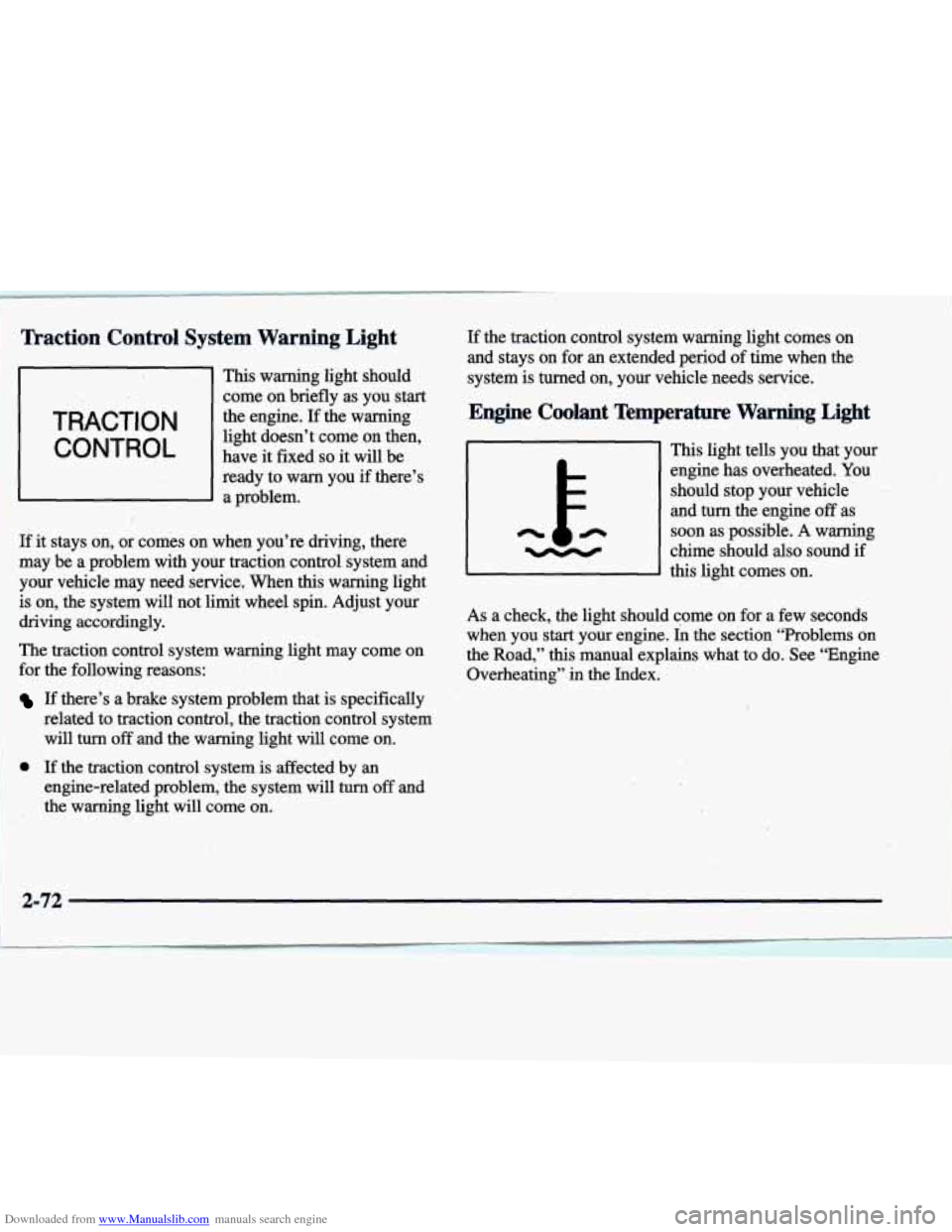
Downloaded from www.Manualslib.com manuals search engine Traction Control System Warning Light
This warning light should
come on briefly as you start
the engine.
If the warning
light doesn’t come on then,
ready to warn you if there’s TRACT^ 0 N
CONTROL have it fixed so it will be
I’ a problem.
i If it stays on, or comes on when you’re driving, there
i may be a problem with your traction control system and
your vehicle may need service. When this warning light is on, the system will not
limit wheel spin. Adjust your
driving accordingly.
The traction control system warning light may come on
for the following reasons:
1 If there’s a brake system problem that is specifically
related to traction control, the traction control system
will
turn off and the warning light will come on.
I 1 0 ‘If the traction control system is affected by an
engine-related problem, the system will turn
off and
the warning light will come on.
If the traction control system warning light comes on
and
stays on for an extended period of time when the
system
is turned on, your vehicle needs service.
Engine Coolant Temperature Warning Light
This light tells you that your
engine has overheated. You
should stop your vehicle
’ ‘3
and.turn the engine off as
soon as’possible.
A warning
chime should
also sound if
this light comes on.
As a check,
the light should come on for a few seconds
when you start your engine.
Ih the section “Problems on
the Road,” this manual explains what to do. See “Engine
Overheating”
in the Index.
Page 144 of 386
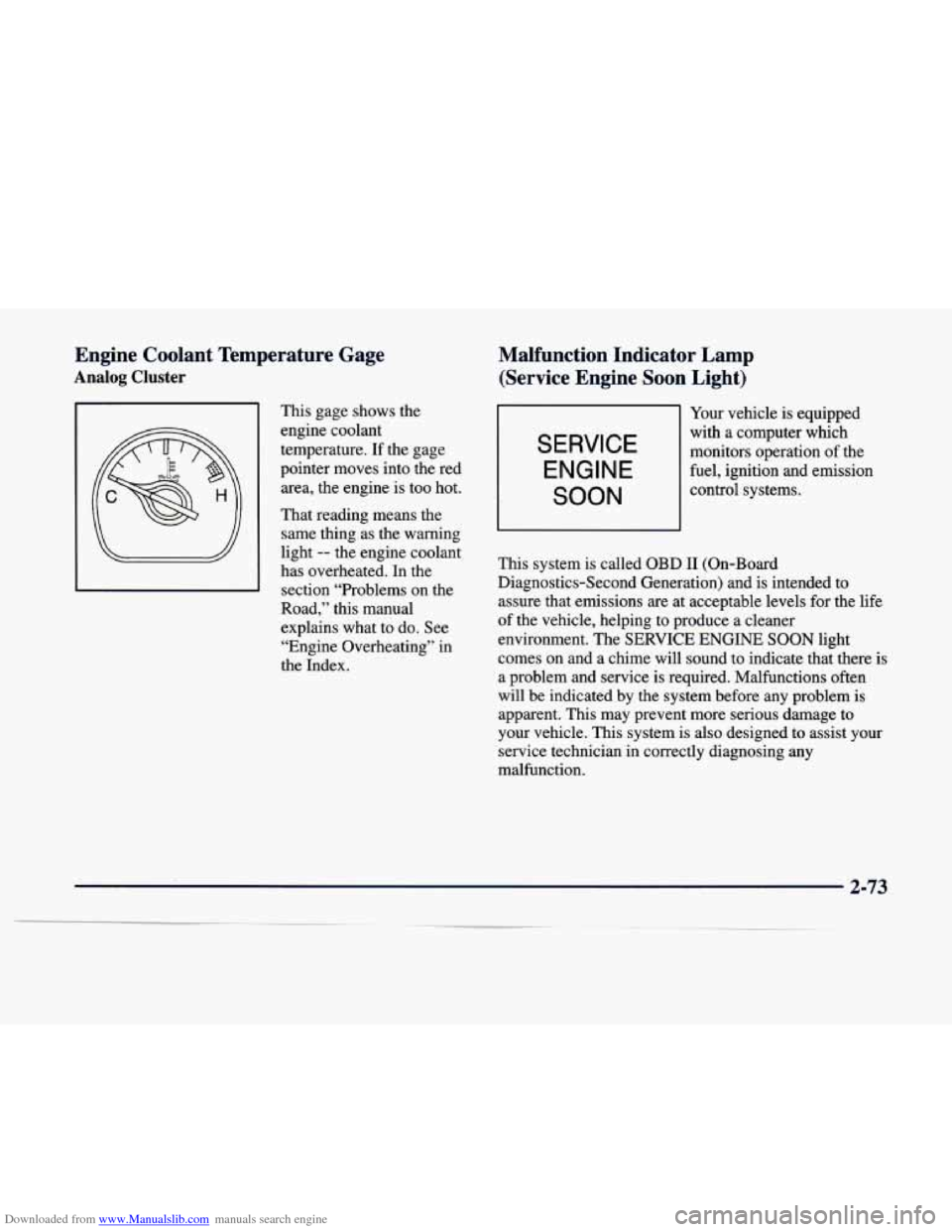
Downloaded from www.Manualslib.com manuals search engine Engine Coolant Temperature Gage
Analog Cluster
This gage shows the
engine coolant
temperature. If the gage
pointer moves into the red area, the engine is too hot.
That reading means the same thing as the warning
light
-- the engine coolant
has overheated.
In the
section “Problems on the
Road,” this manual
explains what to do. See
“Engine Overheating” in
the Index.
Malfunction Indicator Lamp
(Service Engine Soon Light)
Your vehicle is equipped
with a computer which
monitors operation
of the
fuel, ignition and emission
control systems. SERVICE
ENGINE
SOON
This system is called OBD II (On-Board
Diagnostics-Second Generation) and is intended to
assure that emissions are at acceptable levels for the life
of the vehicle, helping to produce a cleaner
environment. The
SERVICE ENGINE SOON light
comes on and a chime will sound to indicate that there is
a problem and service is required. Malfunctions often
will be indicated by the system before
any problem is
apparent. This may prevent more serious damage
to
your vehicle. This system is also designed to assist your
service technician in correctly diagnosing
any
malfunction.
2-73
Page 156 of 386
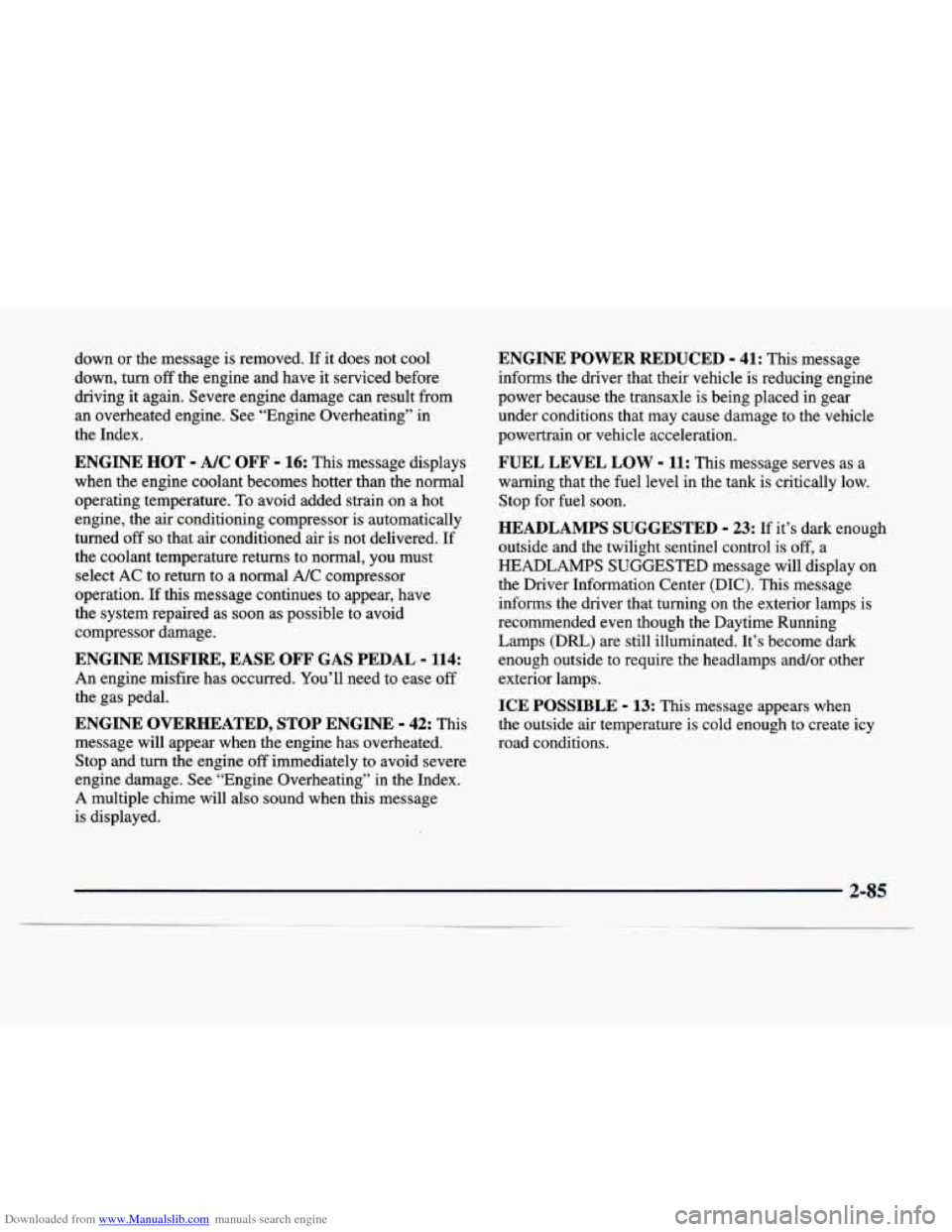
Downloaded from www.Manualslib.com manuals search engine down or the message is removed. If it does not cool
down, turn
off the engine and have it serviced before
driving it again. Severe engine damage can result from
an overheated engine. See “Engine Overheating”
in
the Index.
ENGINE HOT - NC OFF - 16: This message displays
when the engine coolant becomes hotter than the normal
operating temperature.
To avoid added strain on a hot
engine, the
air conditioning compressor is automatically
turned
off so that air conditioned air is not delivered. If
the coolant temperature returns to normal, you must
select AC to return
to a normal A/C compressor
operation. If this message continues to appear, have
the system repaired as soon as possible to avoid
compressor damage.
ENGINE MISFIRE, EASE OFF GAS PEDAL - 114:
An engine misfire has occurred. You’ll need to ease off
the gas pedal.
ENGINE OVERHEATED, STOP ENGINE - 42: This
message
will appear when the engine has overheated.
Stop and turn the engine
off immediately to avoid severe
engine damage. See “Engine Overheating” in the Index.
A multiple chime will also sound when this message
is displayed.
ENGINE POWER REDUCED - 41: This message
informs the driver that their vehicle is reducing engine
power because the transaxle is being placed in gear
under conditions that may cause damage to the vehicle
powertrain or vehicle acceleration.
FUEL LEVEL LOW - 11: This message serves as a
warning that the fuel level in the tank
is critically low.
Stop for fuel soon.
HEADLAMPS SUGGESTED - 23: If it’s dark enough
outside and the twilight sentinel control is
off, a
HEADLAMPS SUGGESTED message will display on
the Driver Information Center (DIC). This message
informs the driver that turning on the exterior lamps is
recommended even though the Daytime Running
Lamps (Dm) are still illuminated. It’s become dark
enough outside to require the headlamps andQr
exterior lamps.
ICE POSSIBLE - 13: This message appears when
the outside air temperature is cold enough to create icy
road conditions.
Page 160 of 386
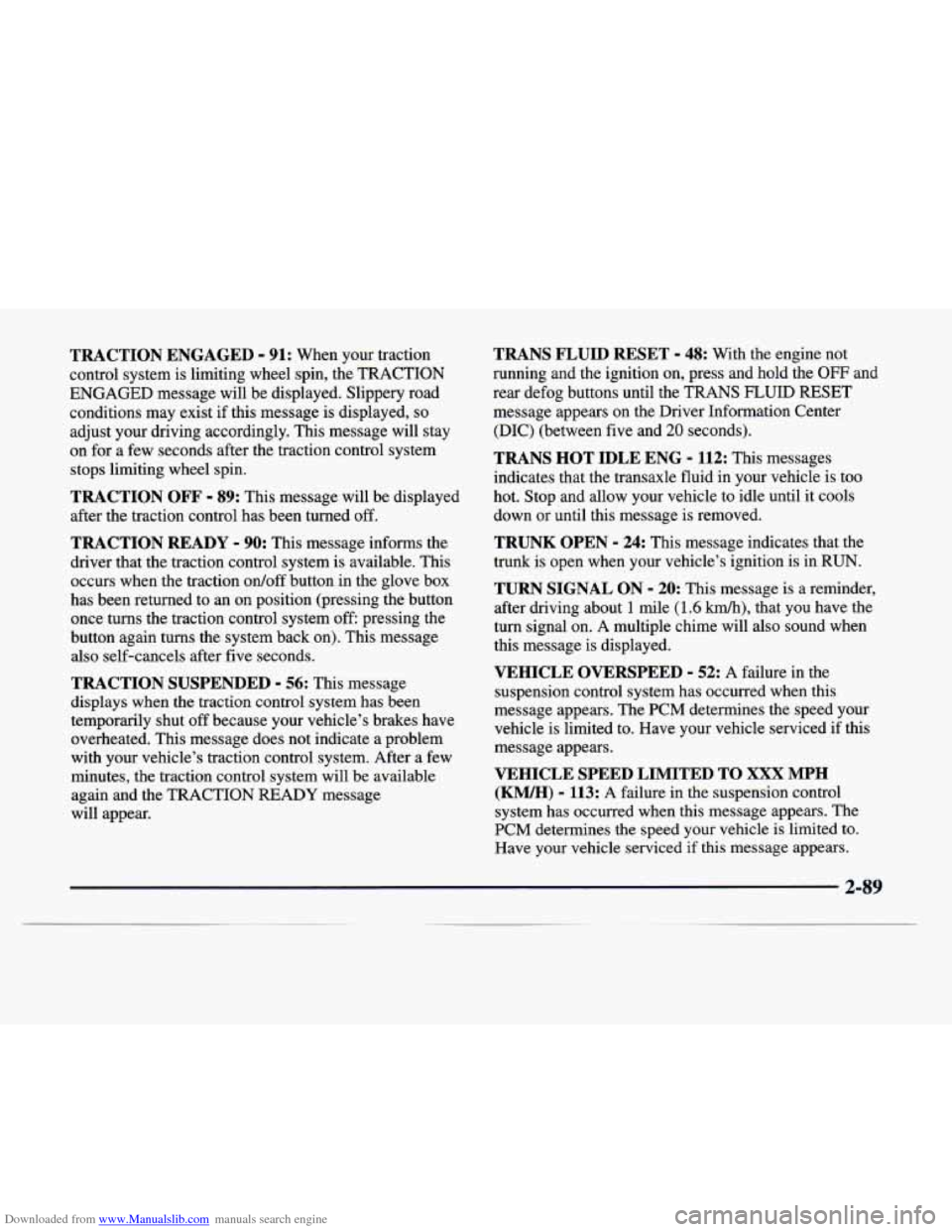
Downloaded from www.Manualslib.com manuals search engine TRACTION ENGAGED - 91: When your traction
control system is limiting wheel spin, the TRACTION
ENGAGED message will be displayed. Slippery road conditions may exist if this message is displayed,
so
adjust your driving accordingly. This message will stay
on for a few seconds after the traction control system
stops limiting wheel spin.
TRACTION OFF - 89: This message will be displayed
after the traction control has been turned off.
TRACTION READY - 90: This message informs the
driver that the traction control system
is available. This
occurs when the traction
ordoff button in the glove box
has been returned to an on position (pressing the button
once turns the traction control system off pressing the
button again turns the system back on). This message
also self-cancels after five seconds.
TRACTION SUSPENDED - 56: This message
displays when the traction control system has been
temporarily shut
off because your vehicle’s brakes have
overheated. This message does not indicate a problem
with your vehicle’s traction control system. After a few
minutes, the traction control system will be available
again and the TRACTION READY message
will appear.
TRANS FLUID RESET - 48: With the engine not
running and the ignition on, press and hold the
OFF and
rear defog buttons until the TRANS FLUID RESET message appears on the Driver Information Center
(DIC) (between
five and 20 seconds).
TRANS HOT IDLE ENG - 112: This messages
indicates that the transaxle fluid in your vehicle is too
hot. Stop and allow your vehicle to idle until it cools
down or until this message is removed.
TRUNK OPEN - 24: This message indicates that the
trunk is open when your vehicle’s ignition is in
RUN.
TURN SIGNAL ON - 20: This message is a reminder,
after driving about
1 mile (1.6 km/h), that you have the
turn signal on. A multiple chime will also sound when
this message is displayed.
VEHICLE OVERSPEED - 52: A failure in the
suspension control system has occurred when this
message appears. The PCM determines the speed your
vehicle is limited to. Have your vehicle serviced if this
message appears.
VEHICLE SPEED LIMITED TO XXX MPH
(KM/H) - 113: A failure in the suspension control
system has occurred when this message appears. The
PCM determines the speed your vehicle is limited to.
Have your vehicle serviced if this message appears.